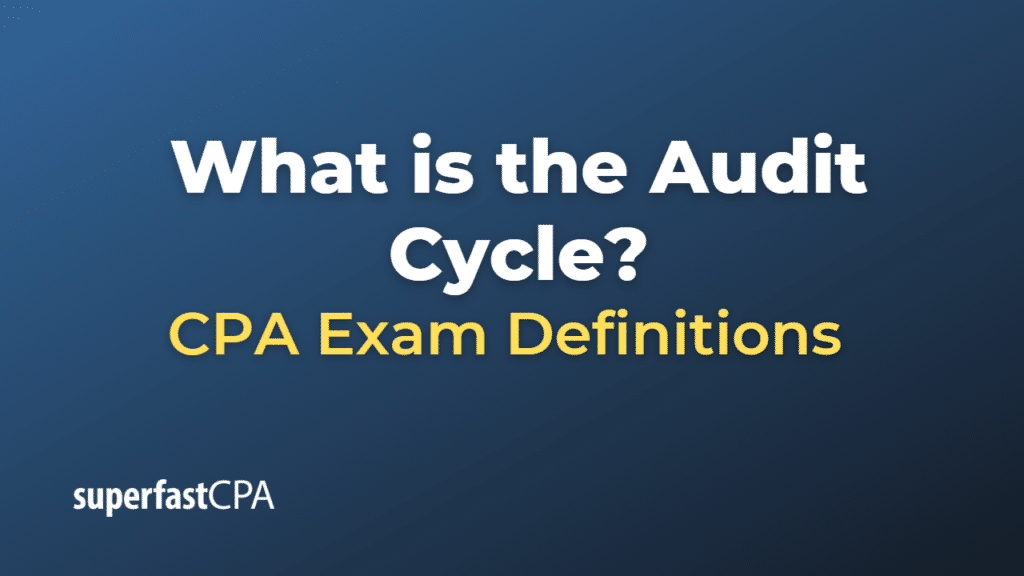Audit Cycle
The audit cycle refers to the recurring process of auditing a company’s financial statements, internal controls, and other relevant areas. The cycle includes several stages, from planning the audit to reporting the results and following up on any recommendations. The length of an audit cycle can vary depending on the size and complexity of the organization being audited and the specific audit requirements.
Here are the main stages of the audit cycle:
- Planning: The auditor starts by gathering information about the company, its industry, and its internal control environment. This phase helps the auditor to identify potential risks and determine the focus of the audit. The auditor may also develop an audit plan, outlining the scope, objectives, and timeline of the audit.
- Risk assessment: The auditor evaluates the company’s risk management processes and internal controls to identify areas of high risk or potential material misstatements. This assessment helps the auditor to prioritize audit procedures and allocate resources effectively.
- Testing: The auditor performs various tests to obtain audit evidence. This may include tests of controls (to evaluate the effectiveness of internal controls) and substantive tests (to verify the accuracy and completeness of financial statement items). The auditor may use a combination of analytical procedures, inspections, inquiries, observations, and confirmations to gather audit evidence.
- Analysis and evaluation: The auditor analyzes the collected audit evidence to identify any discrepancies, misstatements, or control weaknesses. The auditor evaluates the materiality and significance of any identified issues and determines their impact on the financial statements and the overall audit opinion.
- Reporting: The auditor prepares an audit report, which communicates the results of the audit, including the audit opinion on the financial statements and any significant findings. The audit report is typically addressed to the company’s board of directors or audit committee and may be shared with external stakeholders, such as shareholders and regulators.
- Follow-up: After the audit report is issued, the auditor may follow up with the company to ensure that management has addressed any identified issues or implemented the recommended actions. This follow-up may occur during the next audit cycle or through interim communications with the company.
The audit cycle is designed to provide reasonable assurance that a company’s financial statements are free from material misstatements and that its internal controls are operating effectively. Regular audits help to maintain the integrity of financial reporting and build trust between the company and its stakeholders.
Example of the Audit Cycle
Let’s assume we are conducting an audit for a small manufacturing company, XYZ Ltd. Here’s a simplified example of the audit cycle for this company:
- Planning: The auditor researches the manufacturing industry and XYZ Ltd.’s business operations, including its organizational structure, key personnel, and financial reporting processes. The auditor develops an audit plan that outlines the audit’s scope, objectives, and timeline.
- Risk assessment: The auditor identifies potential risks associated with the company, such as inventory valuation, revenue recognition, and management override of controls. The auditor determines that inventory valuation and revenue recognition are areas of high risk and decides to allocate more resources to these areas during the audit.
- Testing: The auditor performs tests of controls, such as reviewing the company’s inventory counting procedures and sales invoice approval process. The auditor also conducts substantive tests, such as physically counting inventory, reconciling inventory records with general ledger accounts, and verifying the accuracy of recorded sales transactions.
- Analysis and evaluation: The auditor discovers discrepancies between the physical inventory count and the inventory records, indicating potential misstatements. The auditor also finds instances where sales were recorded without proper approval. The auditor evaluates the materiality of these issues and determines that they could have a significant impact on the financial statements.
- Reporting: The auditor prepares an audit report, which includes a qualified audit opinion due to the material misstatements found in the inventory and revenue accounts. The report also highlights the identified control weaknesses and recommends improvements to the company’s inventory counting procedures and sales approval process.
- Follow-up: After the audit report is issued, the auditor follows up with XYZ Ltd. to ensure that management has addressed the identified issues and implemented the recommended actions. The auditor confirms that the company has improved its inventory counting procedures and sales approval process during the next audit cycle.
This example demonstrates how the audit cycle works in practice, from planning the audit to following up on recommendations. It’s important to note that real-life audits are usually more complex and may involve additional stages, procedures, and documentation.













